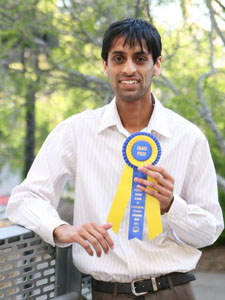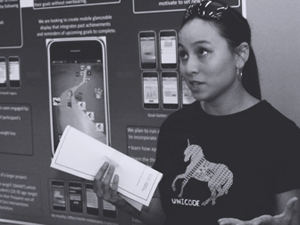Jacobs School Research Expo 2011: Calit2 Research Comes Alive
By Andrea Siedsma, (858) 822-0899, asiedsma@soe.ucsd.
San Diego, Calif., April 20, 2011 — From power amplifiers to social networks and grocery shopping technology for the blind, engineering graduate students affiliated with the University of California, San Diego division of the California Institute of Telecommunications and Information Technology (Calit2) presented their latest research to industry, potential investors and to fellow students and faculty at the Jacobs School of Engineering Research Expo held last week.
|
Electrical engineering Ph.D. student Chirag Patel won the top prize — the Rudee Outstanding Poster Award — at Research Expo 2011 for his work on RF MEMS metal-contact switches. Patel works in the lab of Gabriel Rebeiz, a professor of electrical and computer engineering who is affiliated with Calit2. The top prize itself is named for Lea Rudee, who was the first dean of UCSD's engineering school, and who is currently co-chair of the gallery@calit2 faculty committee.
Calit2 Principal Development Engineer Don Kimball praised Patel for his research, adding that for several years, he’d been in need of just such a switch for his own work on UHF & L-band envelope tracking switch mode power amplifiers.
“The existing RF MEMS switches were always too wimpy for my applications,” Kimball told Patel. “I am so happy that you researched, developed, designed, built and tested an RF MEMS for my kind of power amplifier.”
Patel’s switches could make their way into MRIs and other medical equipment, satellites, and electronic instrumentation such as spectrum analyzers and signal sources. They operate by routing electrical signals using electrostatic fields. They are smaller, lighter and more reliable than the current technology known as “conventional electromagnetic relays” — which route electrical signals using current pulses and magnetic fields.
Read about more about Patel’s research here.
The winning poster for NanoEngineering went to Daniel R. Kagan for his work in “Biological Applications of Catalytic Nanomotors.” Kagan works in the lab of NanoEngineering professor Joseph Wang, who sits on the Calit2 Executive Council at UCSD. The NanoEngineering department is temporarily located on the second floor of xaaaaaaaaaaaaaaaaaaaaaaaacAtkinson Hall. (Watch related videos on the Jacobs School blog.)
Research Expo also included faculty tech talks from all six engineering departments. All talks touched on the event theme, “Innovation for Life.”
Greg Lucier, CEO of Life Technologies, gave the keynote speech, which echoed Calit2's increasing focus on the intersection of engineering and medicine.
Industry leaders from various sectors — from defense to information technology and biotech — got a chance to meet the engineering workforce of the future. Industry sponsors of Research Expo 2011 were ViaSat, Life Technologies and Qualcomm.
“I love coming here just to see the energy and enthusiasm of the kids and to see the technology going on here,” said Nick Patti, senior technical recruiter for Northrop Grumman and a member of the Jacobs School of Engineering Corporate Affiliates Program. “It’s great to see what the students are bringing to the table for the next generation of technology in America.”
Nothing Beats Networking
For electrical and computer engineering graduate student Ramsin Khoshabeh, the Expo provided a vital link for collaboration and possible connections to future employment. He said his advisor, ECE professor and Calit2 participant Truong Q. Nguyen, has already been contacted by a colleague who is eager to work with Khoshabeh and his colleagues in the Calit2-based Video Processing Laboratory (VPL).
“The Expo was vital for providing network opportunities, especially among individuals I’d never ordinarily meet,” added Khoshabeh, whose poster described research into “Spatio-Temporally Consistent Disparity Estimation for Glasses-Free 3D Laparoscopic Surgery.” Read more about his work here.
Also in the realm of electrical and computer engineering, grad student Myoungbo Kwak presented his research on “Wideband High-Efficiency Envelope Tracking Integrated Circuit for Micro-Base Station Power Amplifiers.” Kwak’s method offers a low-cost, high-efficiency means for amplifying signals for wireless mirco-base stations, which typically have a 1 km range.
“What it means to the consumer is that with this technology, your battery will last longer, so you’ll have a lower electricity bill,” he noted.
Kwak pursued his research under the guidance of ECE professor Larry Larson, who leads the Radio Frequency Integrated Circuits Group at UCSD’s industry-funded Center for Wireless Communications, which is a close partner of Calit2.
ECE graduate Natan Haim Jacobson presented his poster on “Saliency for Video Processing Application,” which described a new method for scale-aware saliency detection, or the automatic tagging of regions in an image that would likely draw the attention of a human observer.
By way of example, Jacobson’s poster included an image of a pack of green peppers, with one red pepper in the bunch. A human observer would automatically take note of the red pepper, but a video processor must be trained to do so to render the image with appropriate color and contrast.
“With this method, we use a saliency map to improve the algorithm for video processing and improve motion estimation,” said Jacobson, who is also advised by Prof. Nguyen. “That will give you smoother video at the end of the day.”
Shopping and Interpersonal Informatics
|
“Grocery shopping is a common activity that people all over the world perform on a regular basis. Unfortunately grocery stores and supermarkets are still largely inaccessible to people with visual impairments,” Sikka said.
Sikka and his team have developed an algorithm that will be incorporated in a handheld device with camera and haptic feedback. (Haptic feedback takes advantage of a user’s sense of touch by applying forces, vibrations and/or motions to the user.)
“It’s quite exciting because you’re leveraging computer vision technology to assist people,” said Sikka, whose advisor is computer science and engineering professor (and Calit2 affiliate) Serge Belongie. For more about the Grozi project, watch a video produced by Calit2, which is where much of the work on the technology began (the Grozi segment begins at 0:40)
Sikka said events like Research Expo give him a chance to not only interact with his peers but also with industry. “I always need feedback from industry,” he said, adding that he has an internship at Qualcomm this summer. “Industry is interested in how much you know about your work and how well you can communicate it. A forum like this gives you good contacts and feedback. I’m really jazzed. It’s good to be here.”
In the Department of Computer Science and Engineering (CSE) section of the Research Expo poster exhibit, graduate student Elizabeth Bales explained her project, “Interpersonal Informatics: Bringing Light to Social Influence.” Her research highlights early technological applications for interpersonal informatics, a class of tools that allows groups of people to collect, aggregate, analyze and share personally relevant information.
One goal of interpersonal informatics is to help people understand that what they see around them affects their habits, beliefs, and health, explained Bales, whose advisor is computer science professor William Griswold. Griswold was an early faculty leader for Calit2 and is a principal investigator (PI) or co-PI on a number of Calit2-affiliated projects.
Said Bales: “What we want to do is show people how they can make better decisions by using personal informatics. They can capture what they do every day. With mobile devices and sensors you can track anything.
“Making a positive influence is one of the things that makes we want to continue working on this kind of research,” she added.
Media Contacts
Andrea Siedsma, (858) 822-0899, asiedsma@soe.ucsd.edu
Tiffany Fox, (858) 246-0353, tfox@ucsd.edu
Related Links



